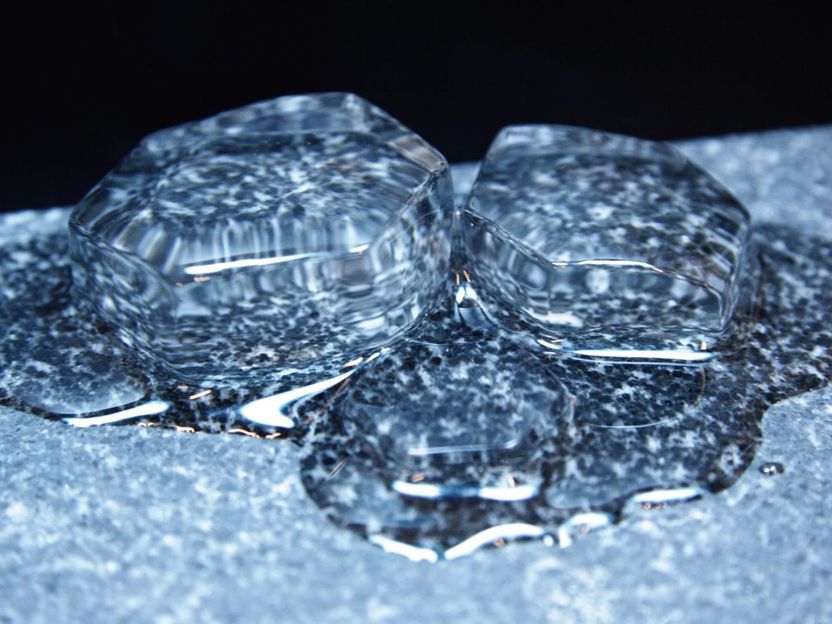How does water melt? Layer by layer!
Advertisement
We all know that water melts at 0°C. However, already 150 years ago the famous physicist Michael Faraday discovered that at the surface of frozen ice, well below 0°C, a thin film of liquid-like water is present. This thin film makes ice slippery and is crucial for the motion of glaciers.

Ice melts as described in the text layer by layer.
© MPIP
Since Faraday's discovery, the properties of this water-like layer have been the research topic of scientists all over the world, which has entailed considerable controversy: at what temperature does the surface become liquid-like? How does the thickness of the layer dependent on temperature? How does the thickness of the layer increases with temperature? Continuously? Stepwise? Experiments to date have generally shown a very thin layer, which continuously grows in thickness up to 45 nm right below the bulk melting point at 0°C. This also illustrates why it has been so challenging to study this layer of liquid-like water on ice: 45 nm is about 1/1000th part of a human hair and is not discernible by eye.
Scientists of the Max Planck Institute for Polymer Research (MPI-P), in a collaboration with researchers from the Netherlands, the USA and Japan, have succeeded to study the properties of this quasi-liquid layer on ice at the molecular level using advanced surface-specific spectroscopy and computer simulations.
The team of scientists around Ellen Backus, group leader at MPI-P, investigated how the thin liquid layer is formed on ice, how it grows with increasing temperature, and if it is distinguishable from normal liquid water. These studies required well-defined ice crystal surfaces. Therefore much effort was put into creating ~10 cm large single crystals of ice, which could be cut in such a way that the surface structure was precisely known. To investigate whether the surface was solid or liquid, the team made use of the fact that water molecules in the liquid have a weaker interaction with each other compared to water molecules in ice. Using their interfacial spectroscopy, combined with the controlled heating of the ice crystal, the researchers were able to quantify the change in the interaction between water molecules directly at the interface between ice and air.
The experimental results, combined with the simulations, showed that the first molecular layer at the ice surface has already molten at temperatures as low as -38° C (235 K), the lowest temperature the researchers could experimentally investigate. Increasing the temperature to -16° C (257 K), the second layer becomes liquid. Contrary to popular belief, the surface melting of ice is not a continuous process, but occurs in a discontinuous, layer-by-layer fashion.
"A further important question for us was, whether one could distinguish between the properties of the quasi-liquid layer and those of normal water" says Mischa Bonn, co-author of the paper and director at the MPI-P. And indeed, the quasi-liquid layer at -4° C (269 K) shows a different spectroscopic response than supercooled water at the same temperature; in the quasi-liquid layer, the water molecules seem to interact more strongly than in liquid water.
The results are not only important for a fundamental understanding of ice, but also for climate science, where much research takes place on catalytic reactions on ice surfaces, for which the understanding of the ice surface structure is crucial.
Original publication
M. Alejandra Sánchez, Tanja Kling, Tatsuya Ishiyama, Marc-Jan van Zadel, Patrick J. Bisson, Markus Mezger, Mara N. Jochum, Jenée D. Cyran, Wilbert J. Smit, Huib J. Bakker, Mary Jane Shultz, Akihiro Morita, Davide Donadio, Yuki Nagata, Mischa Bonn, and Ellen H. G. Backus; "Experimental and theoretical evidence for bilayer-by-bilayer surface melting of crystalline ice"; PNAS; 2016
Other news from the department science
Most read news
More news from our other portals
See the theme worlds for related content
Topic World Spectroscopy
Investigation with spectroscopy gives us unique insights into the composition and structure of materials. From UV-Vis spectroscopy to infrared and Raman spectroscopy to fluorescence and atomic absorption spectroscopy, spectroscopy offers us a wide range of analytical techniques to precisely characterize substances. Immerse yourself in the fascinating world of spectroscopy!

Topic World Spectroscopy
Investigation with spectroscopy gives us unique insights into the composition and structure of materials. From UV-Vis spectroscopy to infrared and Raman spectroscopy to fluorescence and atomic absorption spectroscopy, spectroscopy offers us a wide range of analytical techniques to precisely characterize substances. Immerse yourself in the fascinating world of spectroscopy!





























































